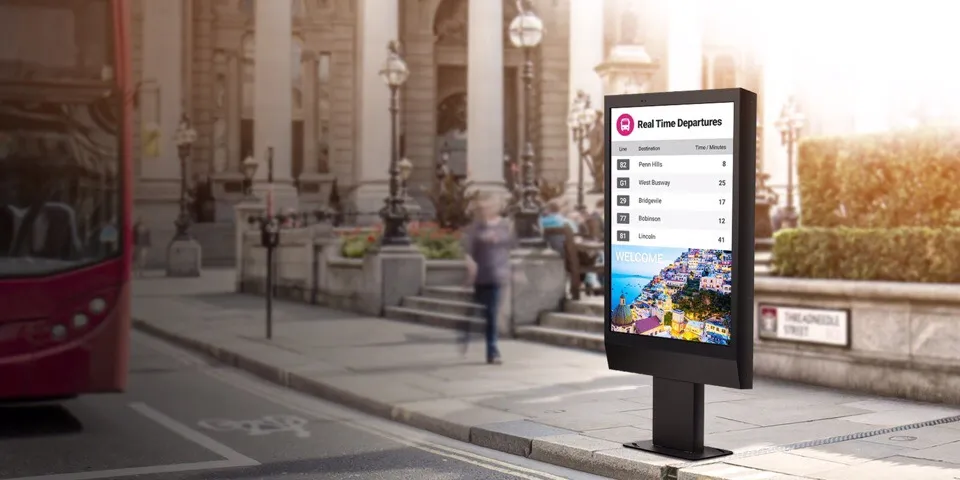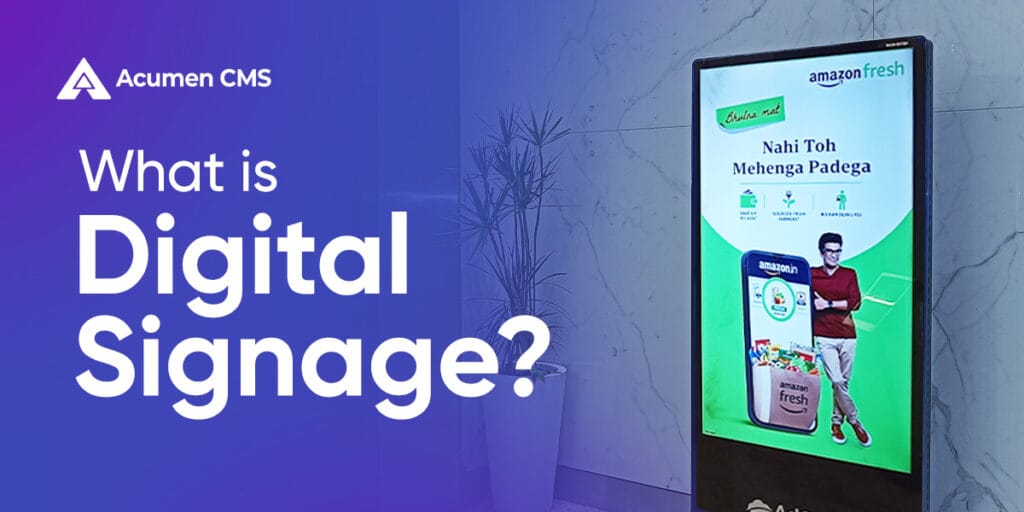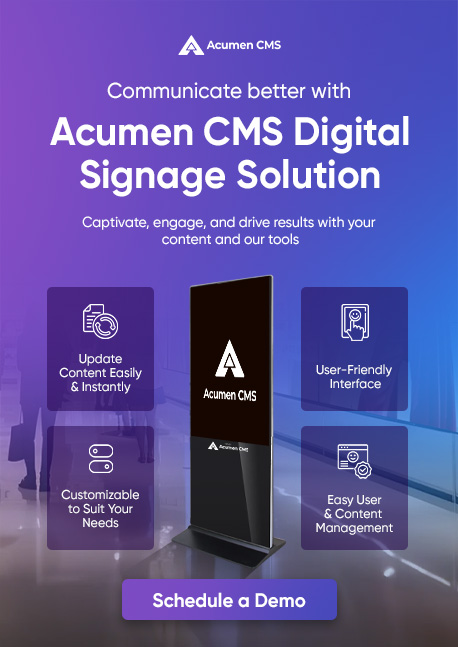India’s digital signage market is expected to cross ₹28,000 crore by 2033, fueled by strong growth in sectors like retail, healthcare, education, and government services (Source: IMARC, 2024). What was once seen only in airports and malls has now found its place in retail stores, clinics, schools, corporate offices and even bus terminals.
But what is digital signage, and is it only meant for big businesses? Not anymore. Even small clinics and QSR outlets use digital displays to attract customers and streamline operations.
- Are you still spending on print banners for every promotion?
- Can your business share real-time updates across locations instantly?
- Are you missing opportunities because customers aren’t informed at the right time?
If these challenges sound familiar, this guide will show you how digital signage can change the way your business operates.
Key Takeaways
- Lowers recurring print and advertising expenses.
- Centralized control for stores, clinics, and office locations.
- Real-time updates for promotions, pricing, and public alerts.
- Easy to manage, even for small business teams.
- Trusted by Indian industries: Retail, QSR, Healthcare, Education, and Public Sector.
What is Digital Signage?
Digital signage is a tech system that displays video, images, or information on digital screens for communication, Digital signage is a modern communication system that uses digital screens to share information. These screens can display text, videos, images, or live data. You’ve seen them outside Reliance Fresh, in Apollo Clinics, or even in IRCTC stations.
They help businesses promote offers, share directions, manage queues, and display important announcements. Unlike print banners, digital signage lets you update content instantly without extra printing costs.
How Does Digital Signage Work?
A digital signage system works through a simple combination of three core components.
- Display Screens : LED or LCD displays placed in shops, clinics, or public places.
- Media Players : Devices that push content from software to screens.
- Content Management Software (CMS) : Controls what appears on each screen and when.
The display screens are responsible for showing the content, while the media players act as a bridge between the CMS and the screens. These devices ensure that the right content appears on the right screens at the scheduled time.
Businesses control all their content through the CMS. From uploading new promotional banners to scheduling festival offers across multiple locations, the CMS allows businesses to manage their screens remotely.
For example, a retail chain like Vishal Mega Mart can run a single Diwali promotion across all its outlets simultaneously through a central dashboard, saving both time and effort.
Key Components of a Digital Signage System
A working digital signage setup relies on the integration of three primary elements: the display screen, the media player, and the digital signage software. Each part plays a unique and essential role in delivering the final content experience that end-users see. For Indian businesses with diverse requirements, understanding these core parts helps make better system choices.
Display Screens
The display screens are the most visible part of the system. Businesses typically use LED screens for outdoor displays because they handle sunlight effectively and offer durability. For indoor environments like retail stores, clinics, and offices, LCD screens are a more budget-friendly choice while still providing excellent display clarity. Commercial-grade monitors are preferred for businesses requiring continuous usage and long operational hours.
Media Players
Media players are small devices that connect the CMS with the display screens. They ensure smooth playback of images, videos, or real-time data. Some businesses use smart TVs with built-in media players to reduce hardware costs, while others prefer dedicated external media players for better control and performance.
Content Management System (CMS)
The Content Management System (CMS) plays a critical role in managing content across all locations. It allows businesses to plan and automate content schedules, manage screen groups by region or department, and even push live updates instantly. Advanced CMS platforms also support integration with CRM systems, enabling businesses to display real-time data, such as stock availability or appointment updates.
Together, these three parts screen, player, and CMS create a complete digital signage system. Each component must work smoothly for content to be shown reliably and effectively across any business location.
Benefits of Digital Signage for Indian Businesses
Implementing digital signage brings both financial and operational benefits.
- Cost Savings: Digital signage reduces the need for printed banners and posters. Over time, this leads to significant savings in marketing and communication expenses.
- Faster Communication: Businesses can update content instantly across all locations, keeping customers informed about new offers and announcements.
- Enhanced Customer Engagement: Visual displays attract more attention and improve the in-store experience, leading to better conversion rates.
- Improved Internal Communication: Corporates and hospitals use digital signage to share real-time information with staff, improving operational efficiency.
Many Indian businesses now use digital signage to manage festival promotions, daily offers, queue management, and internal updates, all from a single platform.
Types of Digital Signage
There are various types of digital signage or screens designed for multiple purposes. We have listed some of the most popular and effective digital signage that helps businesses grow more.
Let’s have a look at them.
1. Outdoor Digital Billboard

These are the large digital screens placed in high-traffic areas, such as streets, and highways, and near transportation hubs. These billboards are generally expensive compared to other digital signage, but they are highly effective in attention-grabbing.
Outdoor Digital Billboards are great for mass communication and large-scale advertising.
2. Indoor Digital Signage

The digital screens you see in malls, airports, offices, and gyms are only indoor digital signage. Their size ranges from smaller screens to large video walls. Nowadays, many retail businesses, such as Shoppers Stop or Lifestyle, use digital screens to display product offers, promotions, or seasonal collections.
3. Digital Menu Screens/ Boards

Digital Menu screens are used by restaurants, cafes, and food courts to display menus, prices, and offers. You must have seen these digital menu boards at McDonalds or Burger King while ordering your food.
You may have also noticed how cleanly these food chains display their extensive menu without clutter or jumble. If you operate a food business, consider installing digital menu boards.
4. Corporate Digital Signage

Corporate digital signage is typically used for internal communications or for displaying operational information by business organizations. It helps firms to keep their employees informed about projects, ensuring all the stakeholders are on the same page.
In short, corporate digital signage is a great tool to reduce communication barriers and enhance a company’s overall performance. Many business organizations also use digital screens to display employee achievements and team performance, improving the work environment and culture.
So, these are some of the types of widely used digital screens. Apart from these 4, there are also other types of digital signages, which include- Interactive Kiosks, Video Walls, Digital Window Displays, and Queue Management Displays.
Where is Digital Signage Used in India?
Digital signage is used across multiple sectors in India, each with its own set of needs. From retail stores to hospitals, the system adapts based on the environment and customer expectations. The following industries are some of the most common users of digital signage today.
Retail
Retailers use digital signage to show live discounts, run festive promotions, and display product demos. Screens placed at entrances, shelves, or billing counters attract customer attention and influence purchase decisions. It helps reduce print costs and allows fast changes across all store locations.
QSR and Hospitality
Quick-service restaurants and hotels use digital signage to improve customer service. Menu boards update pricing and combos instantly. In hotels, digital displays show events, check-in instructions, or local weather updates. This reduces front-desk dependency and improves guest experience.
Education
Schools and universities use digital signage to share event announcements, exam schedules, or campus news. Screens placed in corridors and reception areas keep students and staff informed. It also helps reduce paper notices and manual communication errors.
Healthcare
Hospitals and clinics use digital signage for queue management and appointment updates. Real-time displays reduce crowding at reception desks. Some facilities also use displays to run health awareness messages in waiting areas.
Transport and Government
Bus terminals, metro stations, and government offices use digital signage to share directions, alerts, and public messages. These displays help reduce confusion, guide people, and save staff time spent on repetitive queries.
How to Choose the Right Digital Signage Solution in India?
Choosing the right digital signage solution requires evaluating key factors that impact both current operations and future scalability. The right choice should help your business improve communication, reduce costs, and enhance customer experiences across locations.
1. Define Your Business Goals
Start by identifying the primary purpose of implementing digital signage. Are you focused on improving in-store promotions, managing customer queues, or sharing corporate updates? Clarifying these goals ensures the solution directly supports your business outcomes.
2. Evaluate Content Management Features
A strong content management system (CMS) is essential. Choose a platform that allows easy content creation, scheduling, and management. Ensure it supports varied formats like images, videos, live feeds, and social media integrations, helping you deliver engaging content effortlessly.
3. Check for Scalability
Your business may start with a few screens but expand quickly. Select a solution that easily scales to support additional screens, locations, and user roles without compromising performance or increasing management complexity.
4. Prioritize Integration Capabilities
Ensure the software integrates smoothly with your existing tools such as POS systems, CRM platforms, and inventory software. This allows automated content updates based on real-time data, helping improve marketing efficiency and customer engagement.
5. Review Security and Access Controls
Security should be a priority. Look for platforms offering user role management and data encryption to prevent unauthorized access and protect sensitive business information.
6. Ensure Remote Management Options
For businesses operating across multiple locations, remote management is critical. The solution should provide centralized control to update content and monitor display performance from anywhere.
7. Assess Hardware Compatibility
Confirm that the software works seamlessly with your existing display hardware to avoid extra investment. Compatibility with smart TVs, media players, and existing screens reduces additional infrastructure costs.
8. Consider Customer Support and Training
Choose a vendor that provides reliable customer support, technical assistance, and regular software updates. Access to training resources helps your team operate the system confidently.
If you are interested in a deeper evaluation of providers, you can explore our dedicated guide on Top Digital Signage Provider for a comprehensive comparison.
Why Should You Choose Acumen CMS?
Acumen CMS offers a powerful yet easy-to-use platform for managing digital signage networks across India. Businesses can manage content for a few screens or scale up to thousands of displays without performance issues.
With support for multiple Indian languages, Acumen CMS makes it easy to reach regional audiences effectively. Businesses can control content from a single dashboard and schedule updates to run during peak sales periods or important announcements.
Key Advantages of Acumen CMS:
- Manage content across all locations with one centralized dashboard.
- Support for regional languages like Hindi, Tamil, and Telugu.
- Real-time updates for promotions, stock availability, and public announcements.
- Offline functionality ensures displays work even during internet outages.
- Scalable for businesses ranging from 10 to over 1,000 screens.
Trusted by brands like Coca-Cola, Apollo Hospitals, and Aditya Birla Capital, Acumen CMS helps businesses improve communication and maximize return on investment.
Conclusion
Digital signage offers Indian businesses a cost-effective and highly impactful way to modernize communication and marketing efforts. By reducing recurring costs on printed materials and enabling faster updates, it helps businesses stay ahead of changing customer demands. Whether you’re running a retail store, a healthcare facility, or an educational institution, digital signage improves both internal operations and customer engagement.
With flexible solutions like Acumen CMS, even small businesses can adopt this technology without worrying about high setup costs. Now is the time to upgrade how your business communicates.
Frequently Asked Questions (FAQs)
Digital signage is a screen-based solution for sharing information and promotions. Indian businesses use it to improve customer communication and reduce advertising costs.
Digital signage is used to display content such as advertisements, announcements, or menus on screens. It helps businesses improve customer engagement and communicate messages effectively.
Digital signage delivers customizable, scheduled content for engagement, while TVs primarily provide entertainment. Signage screens integrate with CMS for updates, unlike TVs designed for traditional broadcasting.
The cost ranges from ₹25,000 to ₹5 lakh, depending on hardware, installation, and business size.
Choose a CMS that supports regional languages, offers remote management, and comes with reliable local support.




